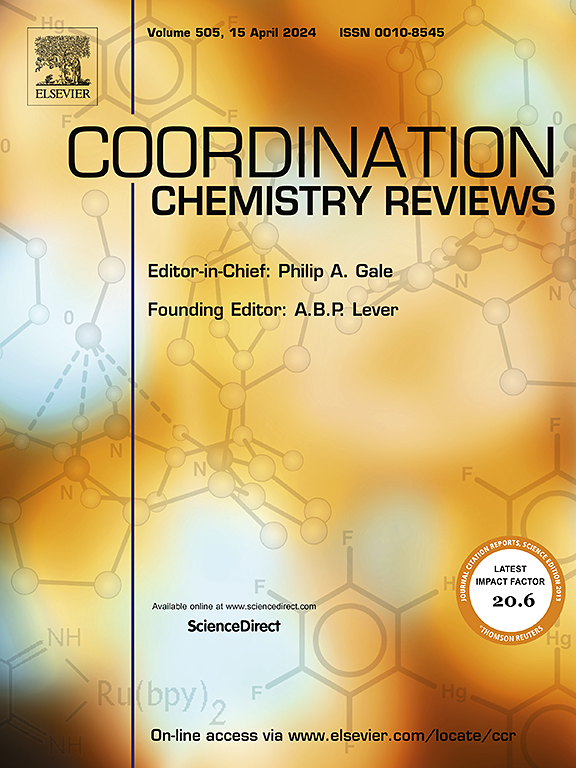Review of KBe2BO3F2-like second-order nonlinear optical materials and their structure-performance relationships
IF 20.3
1区 化学
Q1 CHEMISTRY, INORGANIC & NUCLEAR
引用次数: 0
Abstract
Nonlinear optical (NLO) materials have attracted widespread attention since they can greatly expand the spectral range of the laser output through second harmonic generation (SHG). Recently, employing advantageous structural templates to design and fabricate NLO materials has promoted their rapid development, compared with the traditional “trial-and-error” methodology. KBe2BO3F2, an outstanding usually can be as a good structure prototype for oriented exploring NLO materials. In the crystal structure of KBe2BO3F2, the π-conjugated planar triangle anionic group [BO3]3− and tetrahedra [BeO3F]5− can be replaced by other π-conjugated planar groups and tetrahedra/polyhedra to form KBe2BO3F2-like structures, respectively. After the literature survey, the π-conjugated planar groups are [BO3]3− itself or [BO2]−, [B2O5]4−, [B3O6]3−, [CO3]2−, [BeO3]4−, [BeN3]7−, [BS3]3−, [C(NH2)3]+, while the tetrahedra include [BeO3F]5− itself or [MO4]n− (M = B, P, S, Si, Li, Be, Al, Ga, Zn, Cl; n = 1, 2, 3, 4, 5, 6, 7), [SiN4]8−, [BO3T]4− (T = F, (OH)), [MO2F2]n− (M = P, Si; n = 1, 2), [MO3F]n− (M = Li, S, Y; n = 1, 4, 6), [BeO3(OH)]5−, [AlO3X]4− (X = F, Cl), [ZnO2(OH)2]4−, [ZnO3X]5− (X = (OH), F, Cl, Br), and [ZnS3Br]5−, as well as polyhedra [C3O4H2]2−, [C3H6NO2]−, [AlO3F2]5−, [MgO4F2]8−, [AIIO6]10− (AII = Mg, Ca), [LaO8]13−, [LaO9]15−, [PbO3X3]7− (X = Cl, Br, I), and [IO3]−. Accordingly, about 107 related compounds were collected: 37 borate-halides, 17 fluorooxoborates, 16 borates, 13 γ-Be2BO3F analogues, seven hydroxyborates, four borosulfates, three borophosphates, two guanidiniums, two borosilicates, and one malonate, hydroxycarbonate, carbonate-halide, borate-iodate, sulfate, silicate. According to their relationships between crystal structures and NLO properties: (i) KBe2BO3F2-like materials that can achieve deep-ultraviolet NLO behavior all contain π-conjugated planar groups ([BO3]3−, [CO3]2−, [B3O6]3−) and fluorooxo-heteroleptic tetrahedra ([BO3F]4−, [LiO3F]6−, [SiO2F2]2−, [PO2F2]−). (ii) The combination of the π-conjugated planar groups with large polarization anisotropy and large first-order hyperpolarizability and great HOMO-LUMO energy gaps tetrahedra to design excellent NLO materials is the flexible and benign strategies. (iii) The emergence of the KBe2BO3F2-like infrared NLO structural template has expanded the study sights of infrared NLO materials. The intention is to help insights into the effective designing of novel NLO materials using KBe2BO3F2 as a structural template.
求助全文
约1分钟内获得全文
求助全文
来源期刊

Coordination Chemistry Reviews
化学-无机化学与核化学
CiteScore
34.30
自引率
5.30%
发文量
457
审稿时长
54 days
期刊介绍:
Coordination Chemistry Reviews offers rapid publication of review articles on current and significant topics in coordination chemistry, encompassing organometallic, supramolecular, theoretical, and bioinorganic chemistry. It also covers catalysis, materials chemistry, and metal-organic frameworks from a coordination chemistry perspective. Reviews summarize recent developments or discuss specific techniques, welcoming contributions from both established and emerging researchers.
The journal releases special issues on timely subjects, including those featuring contributions from specific regions or conferences. Occasional full-length book articles are also featured. Additionally, special volumes cover annual reviews of main group chemistry, transition metal group chemistry, and organometallic chemistry. These comprehensive reviews are vital resources for those engaged in coordination chemistry, further establishing Coordination Chemistry Reviews as a hub for insightful surveys in inorganic and physical inorganic chemistry.
 求助内容:
求助内容: 应助结果提醒方式:
应助结果提醒方式:


